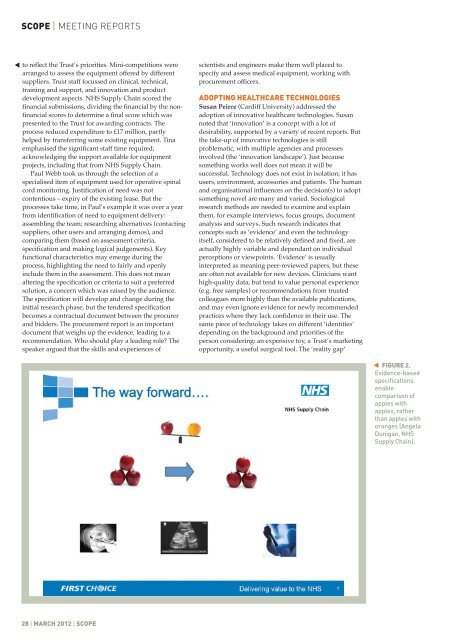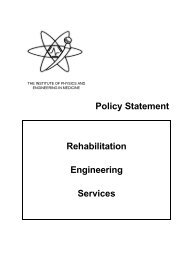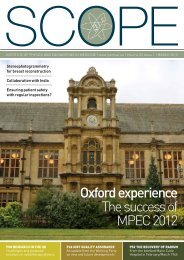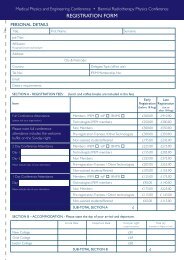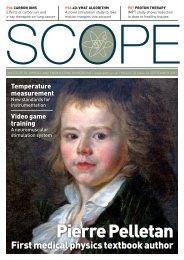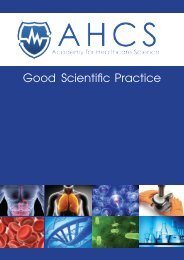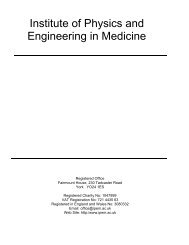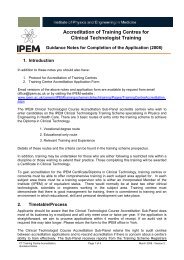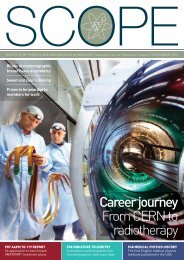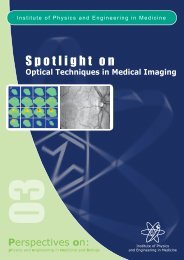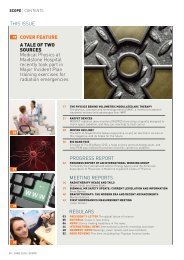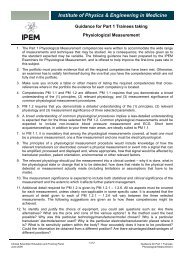March 2012 - Institute of Physics and Engineering in Medicine
March 2012 - Institute of Physics and Engineering in Medicine
March 2012 - Institute of Physics and Engineering in Medicine
Create successful ePaper yourself
Turn your PDF publications into a flip-book with our unique Google optimized e-Paper software.
SCOPE | MEETING REPORTS<br />
▼<br />
to reflect the Trust’s priorities. M<strong>in</strong>i-competitions were<br />
arranged to assess the equipment <strong>of</strong>fered by different<br />
suppliers. Trust staff focussed on cl<strong>in</strong>ical, technical,<br />
tra<strong>in</strong><strong>in</strong>g <strong>and</strong> support, <strong>and</strong> <strong>in</strong>novation <strong>and</strong> product<br />
development aspects. NHS Supply Cha<strong>in</strong> scored the<br />
f<strong>in</strong>ancial submissions, divid<strong>in</strong>g the f<strong>in</strong>ancial by the nonf<strong>in</strong>ancial<br />
scores to determ<strong>in</strong>e a f<strong>in</strong>al score which was<br />
presented to the Trust for award<strong>in</strong>g contracts. The<br />
process reduced expenditure to £17 million, partly<br />
helped by transferr<strong>in</strong>g some exist<strong>in</strong>g equipment. T<strong>in</strong>a<br />
emphasised the significant staff time required,<br />
acknowledg<strong>in</strong>g the support available for equipment<br />
projects, <strong>in</strong>clud<strong>in</strong>g that from NHS Supply Cha<strong>in</strong>.<br />
Paul Webb took us through the selection <strong>of</strong> a<br />
specialised item <strong>of</strong> equipment used for operative sp<strong>in</strong>al<br />
cord monitor<strong>in</strong>g. Justification <strong>of</strong> need was not<br />
contentious – expiry <strong>of</strong> the exist<strong>in</strong>g lease. But the<br />
processes take time, <strong>in</strong> Paul’s example it was over a year<br />
from identification <strong>of</strong> need to equipment delivery:<br />
assembl<strong>in</strong>g the team; research<strong>in</strong>g alternatives (contact<strong>in</strong>g<br />
suppliers, other users <strong>and</strong> arrang<strong>in</strong>g demos), <strong>and</strong><br />
compar<strong>in</strong>g them (based on assessment criteria,<br />
specification <strong>and</strong> mak<strong>in</strong>g logical judgements). Key<br />
functional characteristics may emerge dur<strong>in</strong>g the<br />
process, highlight<strong>in</strong>g the need to fairly <strong>and</strong> openly<br />
<strong>in</strong>clude them <strong>in</strong> the assessment. This does not mean<br />
alter<strong>in</strong>g the specification or criteria to suit a preferred<br />
solution, a concern which was raised by the audience.<br />
The specification will develop <strong>and</strong> change dur<strong>in</strong>g the<br />
<strong>in</strong>itial research phase, but the tendered specification<br />
becomes a contractual document between the procurer<br />
<strong>and</strong> bidders. The procurement report is an important<br />
document that weighs up the evidence, lead<strong>in</strong>g to a<br />
recommendation. Who should play a lead<strong>in</strong>g role The<br />
speaker argued that the skills <strong>and</strong> experiences <strong>of</strong><br />
scientists <strong>and</strong> eng<strong>in</strong>eers make them well placed to<br />
specify <strong>and</strong> assess medical equipment, work<strong>in</strong>g with<br />
procurement <strong>of</strong>ficers.<br />
ADOPTING HEALTHCARE TECHNOLOGIES<br />
Susan Peirce (Cardiff University) addressed the<br />
adoption <strong>of</strong> <strong>in</strong>novative healthcare technologies. Susan<br />
noted that ‘<strong>in</strong>novation’ is a concept with a lot <strong>of</strong><br />
desirability, supported by a variety <strong>of</strong> recent reports. But<br />
the take-up <strong>of</strong> <strong>in</strong>novative technologies is still<br />
problematic, with multiple agencies <strong>and</strong> processes<br />
<strong>in</strong>volved (the ‘<strong>in</strong>novation l<strong>and</strong>scape’). Just because<br />
someth<strong>in</strong>g works well does not mean it will be<br />
successful. Technology does not exist <strong>in</strong> isolation; it has<br />
users, environment, accessories <strong>and</strong> patients. The human<br />
<strong>and</strong> organisational <strong>in</strong>fluences on the decision(s) to adopt<br />
someth<strong>in</strong>g novel are many <strong>and</strong> varied. Sociological<br />
research methods are needed to exam<strong>in</strong>e <strong>and</strong> expla<strong>in</strong><br />
them, for example <strong>in</strong>terviews, focus groups, document<br />
analysis <strong>and</strong> surveys. Such research <strong>in</strong>dicates that<br />
concepts such as ‘evidence’ <strong>and</strong> even the technology<br />
itself, considered to be relatively def<strong>in</strong>ed <strong>and</strong> fixed, are<br />
actually highly variable <strong>and</strong> dependant on <strong>in</strong>dividual<br />
perceptions or viewpo<strong>in</strong>ts. ‘Evidence’ is usually<br />
<strong>in</strong>terpreted as mean<strong>in</strong>g peer-reviewed papers, but these<br />
are <strong>of</strong>ten not available for new devices. Cl<strong>in</strong>icians want<br />
high-quality data, but tend to value personal experience<br />
(e.g. free samples) or recommendations from trusted<br />
colleagues more highly than the available publications,<br />
<strong>and</strong> may even ignore evidence for newly recommended<br />
practices where they lack confidence <strong>in</strong> their use. The<br />
same piece <strong>of</strong> technology takes on different ‘identities’<br />
depend<strong>in</strong>g on the background <strong>and</strong> priorities <strong>of</strong> the<br />
person consider<strong>in</strong>g: an expensive toy, a Trust’s market<strong>in</strong>g<br />
opportunity, a useful surgical tool. The ‘reality gap’<br />
FIGURE 2.<br />
Evidence-based<br />
specifications<br />
enable<br />
comparison <strong>of</strong><br />
apples with<br />
apples, rather<br />
than apples with<br />
oranges (Angela<br />
Dunigan, NHS<br />
Supply Cha<strong>in</strong>).<br />
▼<br />
28 | MARCH <strong>2012</strong> | SCOPE


